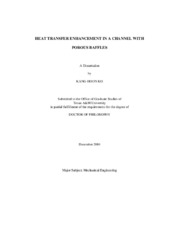| dc.description.abstract | An experimental and numerical investigation of heat transfer enhancement in a
three dimensional channel using wall mounted porous baffles was conducted. The
module average heat transfer coefficients were measured in a uniformly heated
rectangular channel with staggered positioned porous baffles. A numerical procedure
was implemented, in conjunction with a commercially available Navier-Stokes solver, to
model the turbulent flow in porous media. The Brinkman-Forchheimer-Extended Darcy
model was used for modeling fluid flow through the porous baffles. Conventional, oneequation,
and two-equation models were used for heat transfer modeling. The accuracy
and characteristics of each model were investigated and discussed. The results were
compared with experimental data.
Baffles were mounted alternatively on the top and bottom walls. Heat transfer
coefficients and pressure loss for periodically fully developed flow and heat transfer
were obtained for different pore densities (10, 20, and 40 pores per inch (PPI)) with two
different baffle heights ( / h h B D = 1/3 and 2/3), and two baffle thicknesses ( / t h B D = 1/3
and 1/12). The Reynolds number (Re) was varied from 20,000 to 50,000. To compare
the effect of foam metal baffles, the data for conventional solid-type baffles was
obtained for ( / t h B D =1/3). The maximum uncertainties associated with the module
Nusselt number and friction factor were 5.8% and 4.3%, respectively. The experimental
procedure was validated by comparing the data for the straight channel without baffles
( / h h B D = 0) with those in the literature.
The use of porous baffles resulted in heat transfer enhancement as high as 300%
compared to heat transfer in straight channels without baffles. However, the heat transfer
enhancement per unit increase in pumping power was less than one for the range of
parameters studied in this work. Correlation equations were developed for the heat
transfer enhancement ratio and the heat transfer enhancement per unit increase in
pumping power in terms of Reynolds number.
The conventional theoretical model, the dispersion conductivity model, and the
modified two-phase model using the local thermal non-equilibrium theory were
considered. The results from each model were compared against the experimental data,
and compared to each other to investigate the efficiency of each model. Also, the
characteristics of each model were discussed. | en |


